2013 VOLKSWAGEN PASSAT warning
[x] Cancel search: warningPage 293 of 379

Rotating tires
To help ensure even wear on all tires, regular tire rotation according to the diagram ⇒ fig. 176 is
recommended. In this way all tires can have about the same service life.
Volkswagen recommends that you have your tires rotated by an authorized Volkswagen dealer or
authorized Volkswagen Service Facility.
Tires more than 6 years old
Tires age even if they are not being used. Physical and chemical processes reduce tire strength and
performance and cause them to harden and become brittle. Old tires can fail suddenly and without
warning.
Volkswagen recommends replacing tires that are 6 years and older. This also applies to tires that look
new (including the tire on the compact spare wheel) or that seem to still be usable with tread depth
that has not yet reached the legal minimum depth ⇒ .
The age of each tire can be determined with the manufacturing date that is part of the U.S DOT tire
identification number (TIN).
Tire storage
Mark tires before removing them to help make sure that the previous location (left, right, front, rear)
and rolling direction can be maintained when remounting them. Store tires in a cool, dry and preferably
dark place. Do not store tires mounted on wheels standing up.
Tires not mounted on wheels should be covered to help protect them from dirt and stored vertically
(sitting on the tread).
WARNING
Aggressive fluids and materials can cause visible and invisible tire damage that can cause
tire blowouts.
�x Always keep chemicals, oils, grease, fuels, braking fluids and other aggressive
substances away from tires.
WARNING
Tires age even if they are not being used and can fail suddenly, especially at high speeds,
causing loss of vehicle control, accidents, and severe personal injuries.
�x Tires that are more than 6 years old can be used only in an emergency and even then only
with special care and at low speed.
Always dispose of old tires in accordance with legal requirements.
Page 295 of 379
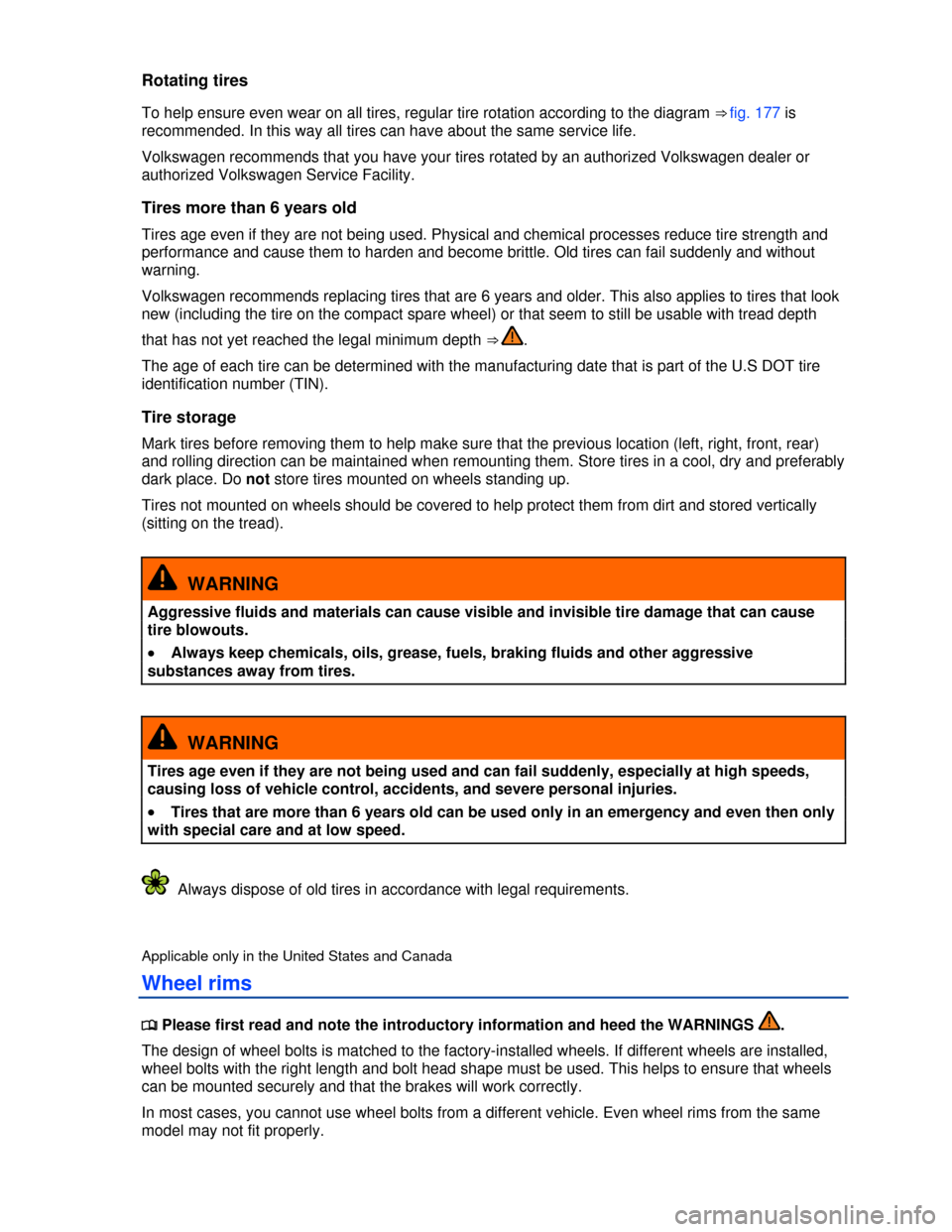
Rotating tires
To help ensure even wear on all tires, regular tire rotation according to the diagram ⇒ fig. 177 is
recommended. In this way all tires can have about the same service life.
Volkswagen recommends that you have your tires rotated by an authorized Volkswagen dealer or
authorized Volkswagen Service Facility.
Tires more than 6 years old
Tires age even if they are not being used. Physical and chemical processes reduce tire strength and
performance and cause them to harden and become brittle. Old tires can fail suddenly and without
warning.
Volkswagen recommends replacing tires that are 6 years and older. This also applies to tires that look
new (including the tire on the compact spare wheel) or that seem to still be usable with tread depth
that has not yet reached the legal minimum depth ⇒ .
The age of each tire can be determined with the manufacturing date that is part of the U.S DOT tire
identification number (TIN).
Tire storage
Mark tires before removing them to help make sure that the previous location (left, right, front, rear)
and rolling direction can be maintained when remounting them. Store tires in a cool, dry and preferably
dark place. Do not store tires mounted on wheels standing up.
Tires not mounted on wheels should be covered to help protect them from dirt and stored vertically
(sitting on the tread).
WARNING
Aggressive fluids and materials can cause visible and invisible tire damage that can cause
tire blowouts.
�x Always keep chemicals, oils, grease, fuels, braking fluids and other aggressive
substances away from tires.
WARNING
Tires age even if they are not being used and can fail suddenly, especially at high speeds,
causing loss of vehicle control, accidents, and severe personal injuries.
�x Tires that are more than 6 years old can be used only in an emergency and even then only
with special care and at low speed.
Always dispose of old tires in accordance with legal requirements.
Applicable only in the United States and Canada
Wheel rims
�
Page 296 of 379
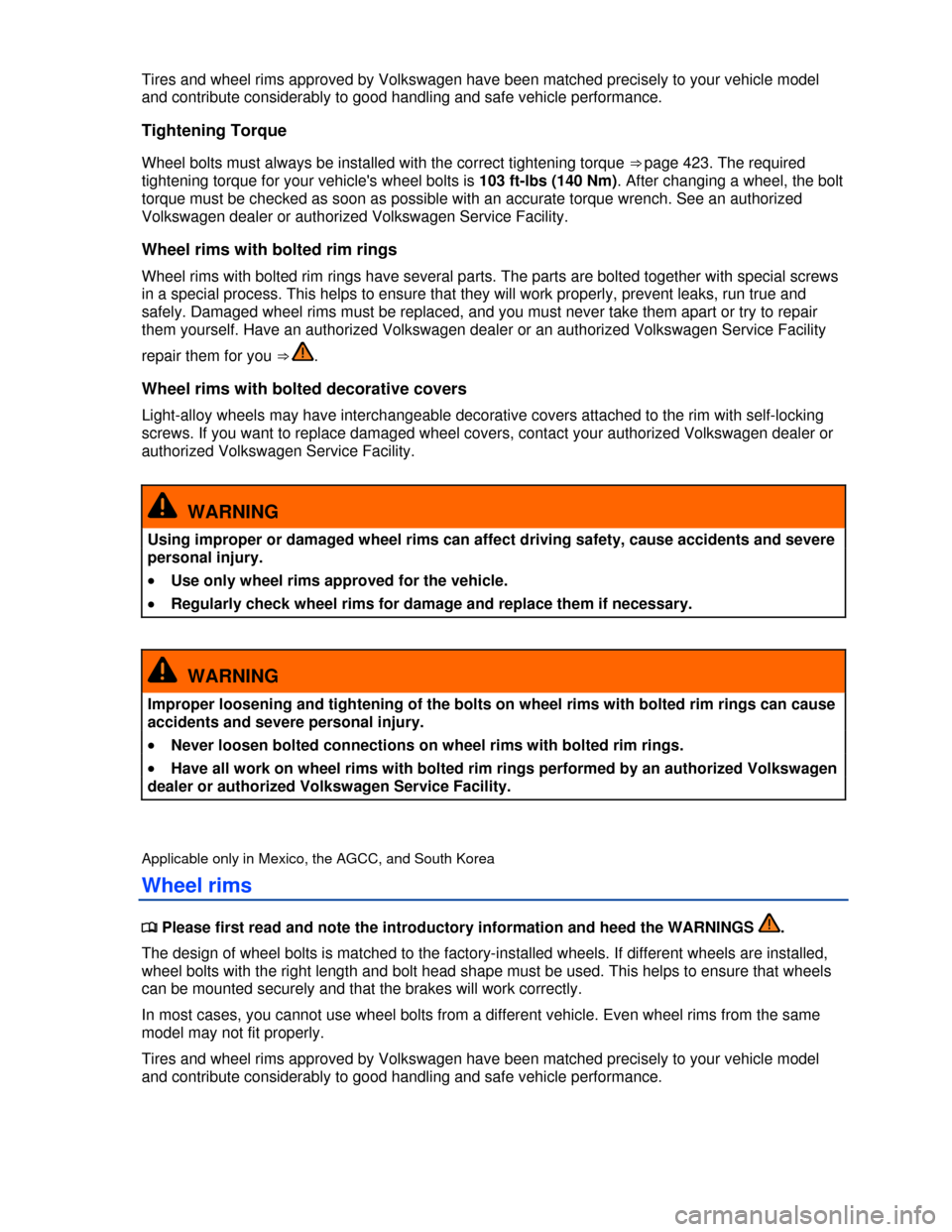
Tires and wheel rims approved by Volkswagen have been matched precisely to your vehicle model
and contribute considerably to good handling and safe vehicle performance.
Tightening Torque
Wheel bolts must always be installed with the correct tightening torque ⇒ page 423. The required
tightening torque for your vehicle's wheel bolts is 103 ft-lbs (140 Nm). After changing a wheel, the bolt
torque must be checked as soon as possible with an accurate torque wrench. See an authorized
Volkswagen dealer or authorized Volkswagen Service Facility.
Wheel rims with bolted rim rings
Wheel rims with bolted rim rings have several parts. The parts are bolted together with special screws
in a special process. This helps to ensure that they will work properly, prevent leaks, run true and
safely. Damaged wheel rims must be replaced, and you must never take them apart or try to repair
them yourself. Have an authorized Volkswagen dealer or an authorized Volkswagen Service Facility
repair them for you ⇒ .
Wheel rims with bolted decorative covers
Light-alloy wheels may have interchangeable decorative covers attached to the rim with self-locking
screws. If you want to replace damaged wheel covers, contact your authorized Volkswagen dealer or
authorized Volkswagen Service Facility.
WARNING
Using improper or damaged wheel rims can affect driving safety, cause accidents and severe
personal injury.
�x Use only wheel rims approved for the vehicle.
�x Regularly check wheel rims for damage and replace them if necessary.
WARNING
Improper loosening and tightening of the bolts on wheel rims with bolted rim rings can cause
accidents and severe personal injury.
�x Never loosen bolted connections on wheel rims with bolted rim rings.
�x Have all work on wheel rims with bolted rim rings performed by an authorized Volkswagen
dealer or authorized Volkswagen Service Facility.
Applicable only in Mexico, the AGCC, and South Korea
Wheel rims
�
Page 297 of 379
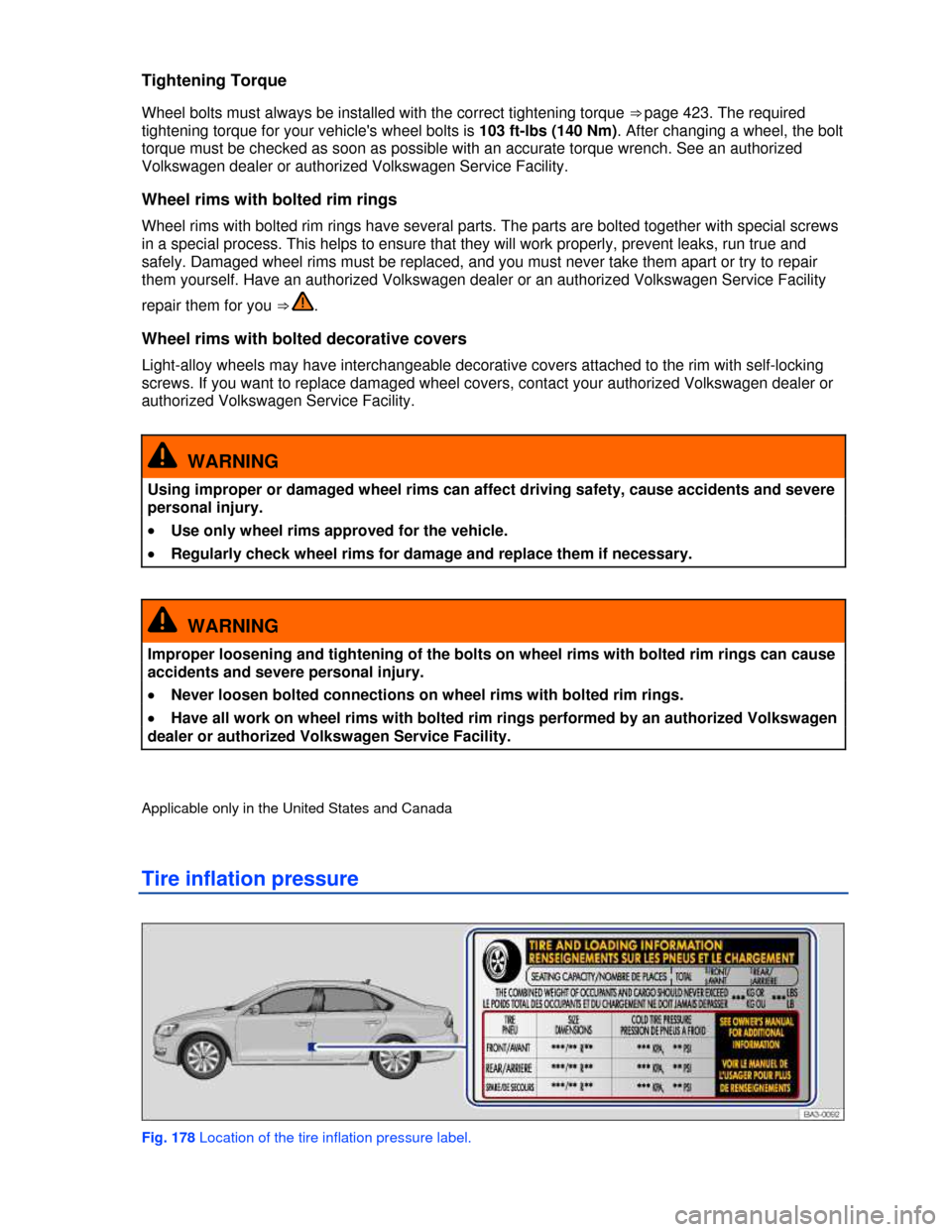
Tightening Torque
Wheel bolts must always be installed with the correct tightening torque ⇒ page 423. The required
tightening torque for your vehicle's wheel bolts is 103 ft-lbs (140 Nm). After changing a wheel, the bolt
torque must be checked as soon as possible with an accurate torque wrench. See an authorized
Volkswagen dealer or authorized Volkswagen Service Facility.
Wheel rims with bolted rim rings
Wheel rims with bolted rim rings have several parts. The parts are bolted together with special screws
in a special process. This helps to ensure that they will work properly, prevent leaks, run true and
safely. Damaged wheel rims must be replaced, and you must never take them apart or try to repair
them yourself. Have an authorized Volkswagen dealer or an authorized Volkswagen Service Facility
repair them for you ⇒ .
Wheel rims with bolted decorative covers
Light-alloy wheels may have interchangeable decorative covers attached to the rim with self-locking
screws. If you want to replace damaged wheel covers, contact your authorized Volkswagen dealer or
authorized Volkswagen Service Facility.
WARNING
Using improper or damaged wheel rims can affect driving safety, cause accidents and severe
personal injury.
�x Use only wheel rims approved for the vehicle.
�x Regularly check wheel rims for damage and replace them if necessary.
WARNING
Improper loosening and tightening of the bolts on wheel rims with bolted rim rings can cause
accidents and severe personal injury.
�x Never loosen bolted connections on wheel rims with bolted rim rings.
�x Have all work on wheel rims with bolted rim rings performed by an authorized Volkswagen
dealer or authorized Volkswagen Service Facility.
Applicable only in the United States and Canada
Tire inflation pressure
Fig. 178 Location of the tire inflation pressure label.
Page 300 of 379
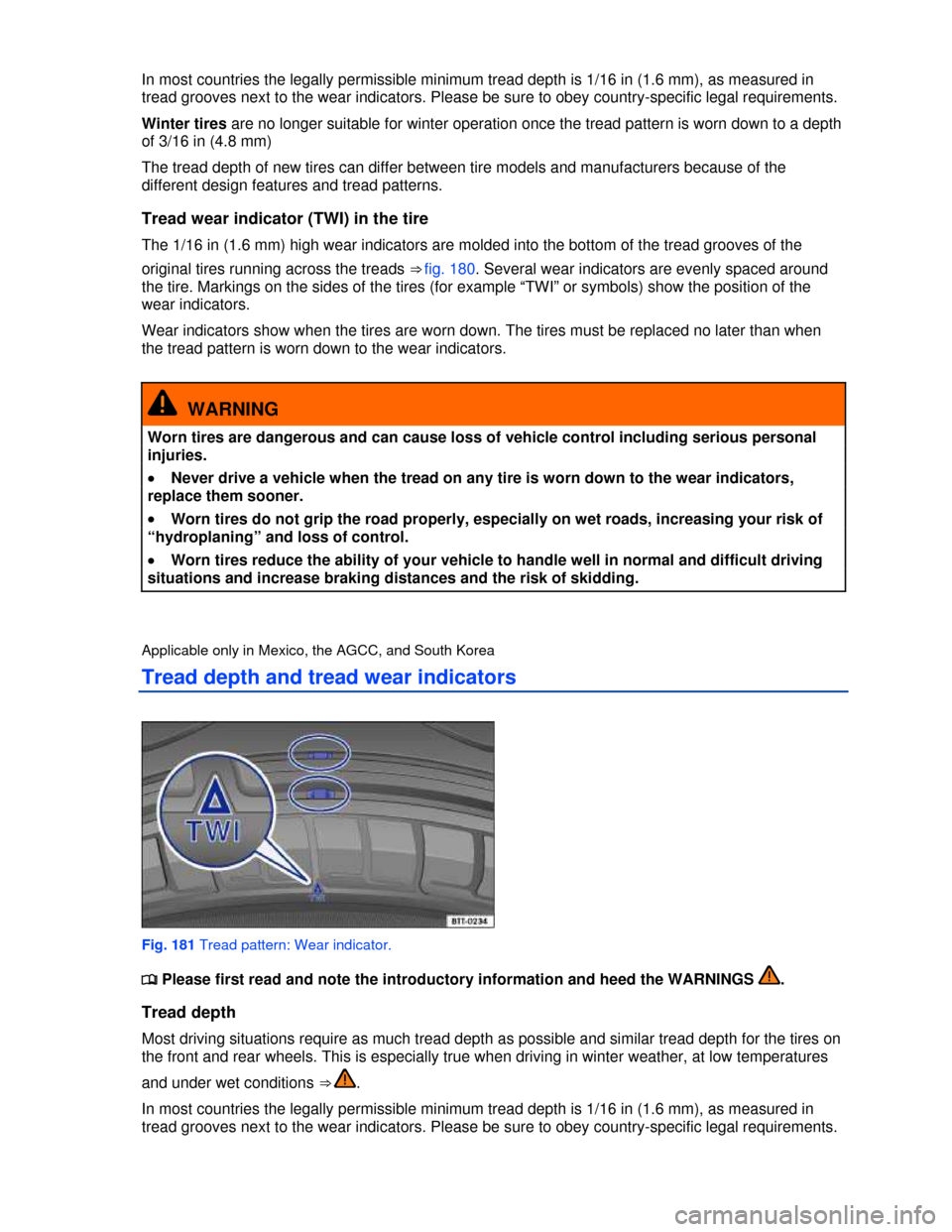
In most countries the legally permissible minimum tread depth is 1/16 in (1.6 mm), as measured in
tread grooves next to the wear indicators. Please be sure to obey country-specific legal requirements.
Winter tires are no longer suitable for winter operation once the tread pattern is worn down to a depth
of 3/16 in (4.8 mm)
The tread depth of new tires can differ between tire models and manufacturers because of the
different design features and tread patterns.
Tread wear indicator (TWI) in the tire
The 1/16 in (1.6 mm) high wear indicators are molded into the bottom of the tread grooves of the
original tires running across the treads ⇒ fig. 180. Several wear indicators are evenly spaced around
the tire. Markings on the sides of the tires (for example “TWI” or symbols) show the position of the
wear indicators.
Wear indicators show when the tires are worn down. The tires must be replaced no later than when
the tread pattern is worn down to the wear indicators.
WARNING
Worn tires are dangerous and can cause loss of vehicle control including serious personal
injuries.
�x Never drive a vehicle when the tread on any tire is worn down to the wear indicators,
replace them sooner.
�x Worn tires do not grip the road properly, especially on wet roads, increasing your risk of
“hydroplaning” and loss of control.
�x Worn tires reduce the ability of your vehicle to handle well in normal and difficult driving
situations and increase braking distances and the risk of skidding.
Applicable only in Mexico, the AGCC, and South Korea
Tread depth and tread wear indicators
Fig. 181 Tread pattern: Wear indicator.
�
Page 301 of 379
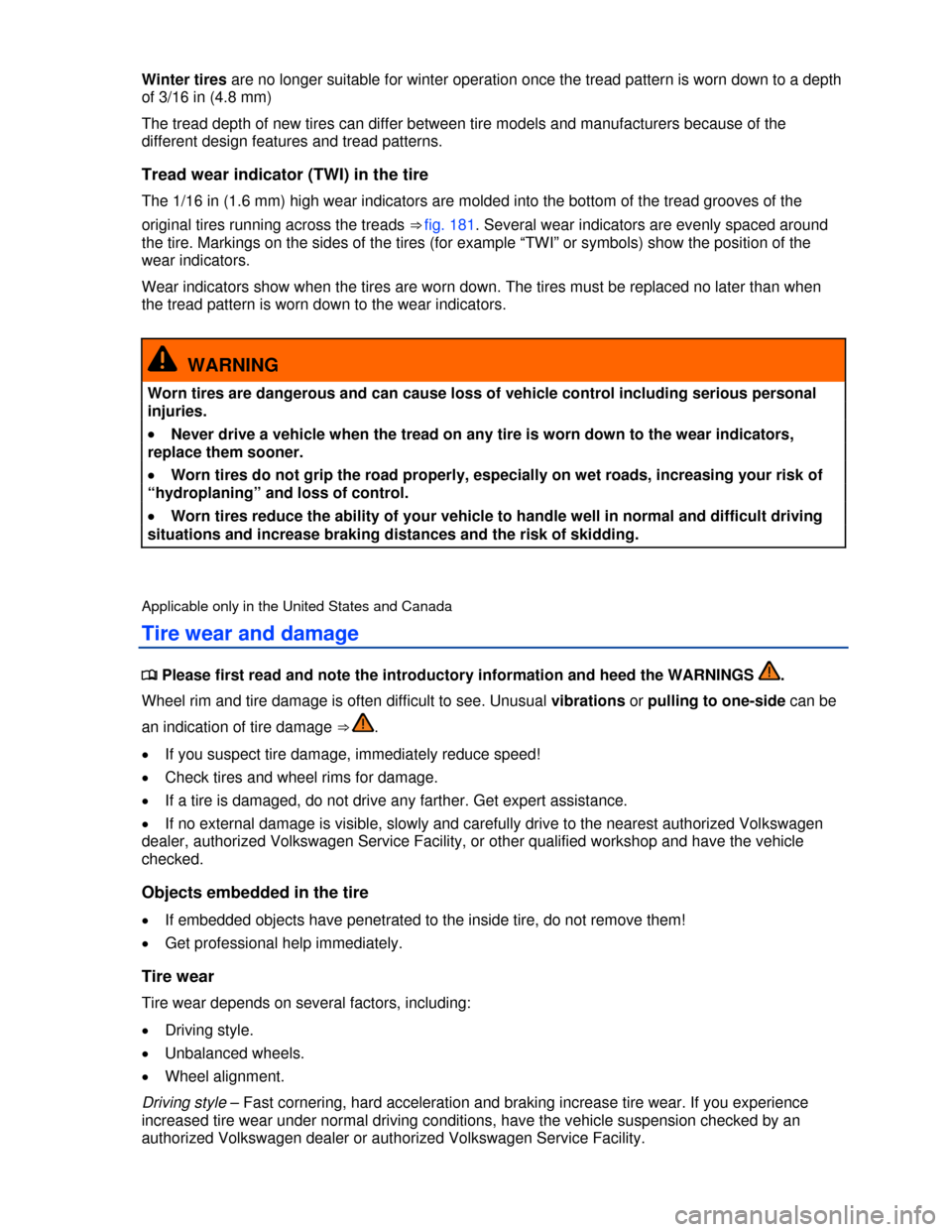
Winter tires are no longer suitable for winter operation once the tread pattern is worn down to a depth
of 3/16 in (4.8 mm)
The tread depth of new tires can differ between tire models and manufacturers because of the
different design features and tread patterns.
Tread wear indicator (TWI) in the tire
The 1/16 in (1.6 mm) high wear indicators are molded into the bottom of the tread grooves of the
original tires running across the treads ⇒ fig. 181. Several wear indicators are evenly spaced around
the tire. Markings on the sides of the tires (for example “TWI” or symbols) show the position of the
wear indicators.
Wear indicators show when the tires are worn down. The tires must be replaced no later than when
the tread pattern is worn down to the wear indicators.
WARNING
Worn tires are dangerous and can cause loss of vehicle control including serious personal
injuries.
�x Never drive a vehicle when the tread on any tire is worn down to the wear indicators,
replace them sooner.
�x Worn tires do not grip the road properly, especially on wet roads, increasing your risk of
“hydroplaning” and loss of control.
�x Worn tires reduce the ability of your vehicle to handle well in normal and difficult driving
situations and increase braking distances and the risk of skidding.
Applicable only in the United States and Canada
Tire wear and damage
�
Page 302 of 379

Unbalanced wheels – The wheels on a new vehicle are balanced. When driving, however, various
conditions can cause a wheel to become unbalanced. Unbalanced wheels can cause wear to the
steering and suspension systems. Have all wheels rebalanced. A wheel must always be rebalanced if
a new tire has been mounted.
Wheel alignment – Incorrect wheel alignment causes excessive and uneven tire wear, impairing
vehicle safety. If you notice excessive or uneven tire wear, have the wheel alignment checked by an
authorized Volkswagen dealer or authorized Volkswagen Service Facility.
WARNING
Unusual vibrations or pulling to one side can indicate tire damage.
�x Reduce speed immediately and stop when it is safe to do so.
�x Check tires and wheel rims for damage.
�x Never drive with a damaged tire or rim. Get expert assistance instead.
�x If no external damage is visible, slowly and carefully drive to the nearest authorized
Volkswagen dealer, authorized Volkswagen Service Facility, or other qualified workshop and
have the vehicle checked.
Applicable only in Mexico, the AGCC, and South Korea
Tire wear and damage
�
Page 303 of 379

Wheel alignment – Incorrect wheel alignment causes excessive and uneven tire wear, impairing
vehicle safety. If you notice excessive or uneven tire wear, have the wheel alignment checked by an
authorized Volkswagen dealer or authorized Volkswagen Service Facility.
WARNING
Unusual vibrations or pulling to one side can indicate tire damage.
�x Reduce speed immediately and stop when it is safe to do so.
�x Check tires and wheel rims for damage.
�x Never drive with a damaged tire or rim. Get expert assistance instead.
�x If no external damage is visible, slowly and carefully drive to the nearest authorized
Volkswagen dealer or authorized Volkswagen Service Facility or other qualified workshop
and have the vehicle checked.
Applicable only in the United States and Canada
Compact spare wheel
Fig. 182 In the luggage compartment: Compact spare wheel.
�